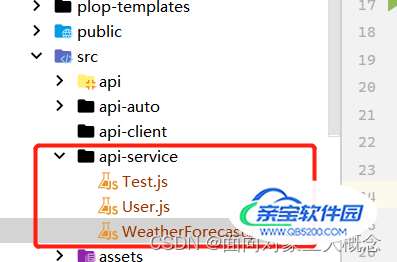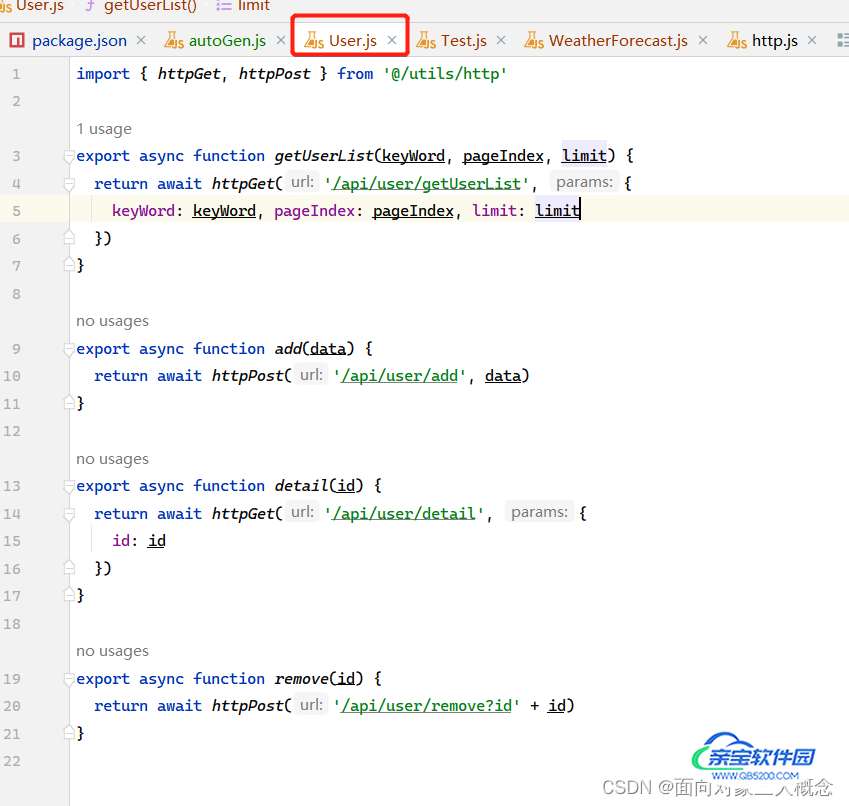vue 自动生成swagger接口请求文件的方法
面向对象三大概念 人气:0前端: vue-element-admin
后端: .net core (6.0)
找了很多自动生成的代码的,感觉不太行,可能是我不太懂。所以自己根据swagger.json去生成了js请求文件。
后端很简单,就不说了,只要能访问到swagger的地址就可以,主要是前端。这个生成的比较简单,你们可以根据自己的需求修改生成文件js里的代码。前端代码也参考了网上的一些内容。
1.在项目目录下新建genSwagger文件夹,然后新建autoGen.js文件

2.autoGen.js文件内容如下,里面的内容大部分有注释,可以根据自己的项目情况做些修改
const fs = require('fs')
const path = require('path')
let apiData = {} // 访问swagger.json的数据
const http = require('http')
const apiUrl = 'http://localhost:5227/swagger/v1/swagger.json' // swagger.json的地址,这里是本地的,可以替换成你的地址,有个问题是目前只能是http,https的不行,https会报一个证书错误
// 生成api文件的目录
function mkdirsSync(dirname) {
if (fs.existsSync(dirname)) {
return true
} else {
if (mkdirsSync(path.dirname(dirname))) {
fs.mkdirSync(dirname)
return true
}
}
}
function getPath(pathUrl) {
return path.resolve(__dirname, pathUrl)
}
let dataList = [] // 真正要处理的数据
// 将swagger.json中的数据转换成我们需要的数据
function getDataList() {
// 遍历apiData.paths
for (const key in apiData.paths) {
let routeData = {}
routeData.api = key
console.log('path================ ' + key)
// 遍历apiData.paths[key]
for (let key2 in apiData.paths[key]) {
routeData.method = key2
console.log('methods============== ' + key2)
let tag = apiData.paths[key][key2].tags[0]
console.log('tag=====' + tag)
routeData.controller = tag
let params = apiData.paths[key][key2].parameters
if (params) {
routeData.bodyType = 'query'
routeData.params = apiData.paths[key][key2].parameters
} else {
routeData.params = []
if (key2 === 'post' && key2 !== 'get') {
routeData.bodyType = 'body'
let requestBody = apiData.paths[key][key2].requestBody
if (requestBody) {
let content = requestBody.content
if (content) {
let applicationJson = content['application/json']
if (applicationJson) {
let schema = applicationJson.schema
if (schema) {
let properties = schema.$ref
if (properties) {
let ref = properties.split('/')
let refName = ref[ref.length - 1]
let refData = apiData.components.schemas[refName]
if (refData) {
let refProperties = refData.properties
if (refProperties) {
for (let key3 in refProperties) {
let param = {}
param.name = key3
param.in = 'body'
param.required = true
param.schema = refProperties[key3]
routeData.params.push(param)
}
}
}
}
}
}
}
}
}
}
//遍历apiData.paths[key][key2]
for (let key3 in apiData.paths[key][key2]) {
// console.log('tags===========' + key3)
if (key2 === 'get') {
//routeData.params = apiData.paths[key][key2][key3].parameters
}
//routeData.other = apiData.paths[key][key2][key3]
console.log(apiData.paths[key][key2][key3])
}
console.log('xxxxxxxxxxxxxxxxxxxxxxxxxxxxx')
}
dataList.push(routeData)
}
console.log(dataList)
}
// 获取远程swagger.json的数据
function httpGetJson(url) {
return new Promise((resolve, reject) => {
http.get(url, (res) => {
const { statusCode } = res
const contentType = res.headers['content-type']
let error
if (statusCode !== 200) {
error = new Error('请求失败。\n' + `状态码: ${statusCode}`)
} else if (!/^application\/json/.test(contentType)) {
error = new Error('无效的 content-type.\n' + `期望 application/json 但获取的是 ${contentType}`)
}
if (error) {
console.log('error')
// 消耗响应数据以释放内存
console.error(error.message)
res.resume()
return
}
res.setEncoding('utf8')
let rawData = ''
res.on('data', (chunk) => {
rawData += chunk
})
res.on('end', () => {
try {
const parsedData = JSON.parse(rawData)
resolve(parsedData)
} catch (e) {
reject(`错误: ${e.message}`)
}
})
}).on('error', (e) => {
reject(`错误: ${e.message}`)
})
})
}
// 生成http请求js文件
async function createHttpJsFile() {
console.log('start')
apiData = await httpGetJson(apiUrl)
getDataList()
console.log(dataList)
if (dataList.length === 0) {
console.log('请先点击getUsers按钮')
return
}
let httpJs = ''
if (dataList.length > 0) {
const dirPath = '/src/api-service'
// dataList根据controller去重
const controllerList = []
for (let i = 0; i < dataList.length; i++) {
const routeData = dataList[i]
const controller = routeData.controller
if (controllerList.indexOf(controller) === -1) {
controllerList.push(controller)
}
}
// 生成http请求js文件
for (let i = 0; i < controllerList.length; i++) {
httpJs += `import { httpGet, httpPost } from '@/utils/http'\n`
const fileName = controllerList[i]
// 查找dataList里与 controllerList[i]相同的数据 (同一个controller的api放在一起)
const controllerDataList = dataList.filter(item => item.controller === controllerList[i])
console.log(controllerDataList)
for (const data of controllerDataList) {
const api = data.api // /api/user/getUserList
// 取出api中最后一个斜杠后面的内容
const apiName = api.substring(api.lastIndexOf('/') + 1)
if (data.method === 'get') {
httpJs += `export async function ${apiName}(`
if (data.params && data.params.length > 0) {
for (let i = 0; i < data.params.length; i++) {
const param = data.params[i]
if (i === 0) {
httpJs += `${param.name}`
} else {
httpJs += `,${param.name}`
}
}
}
httpJs += `) {\n`
httpJs += ` return await httpGet('${data.api}'`
if (data.params && data.params.length > 0) {
httpJs += `,{\n`
for (let i = 0; i < data.params.length; i++) {
const param = data.params[i]
if (i === 0) {
httpJs += ` ${param.name}:${param.name}`
} else {
httpJs += ` ,${param.name}:${param.name}`
}
}
httpJs += ` })\n`
httpJs += `}\n`
} else {
httpJs += `)}\n`
}
} else if (data.method === 'post') {
// post后面带参数
if (data.params.length > 0 && data.bodyType === 'query') {
httpJs += 'export async function ' + apiName + '('
for (let i = 0; i < data.params.length; i++) {
const param = data.params[i]
if (i === 0) {
httpJs += `${param.name}`
} else {
httpJs += `,${param.name}`
}
}
httpJs += `) {\n`
httpJs += ` return await httpPost('${data.api}`
if (data.params && data.params.length > 0) {
for (let i = 0; i < data.params.length; i++) {
const param = data.params[i]
if (i === 0) {
httpJs += `?${param.name}='+${param.name}`
} else {
httpJs += `+'&${param.name}='+${param.name}`
}
}
httpJs += `)}\n`
} else {
httpJs += `)}\n`
}
} else {
httpJs += 'export async function ' + apiName + '(data) {\n'
httpJs += ' return await httpPost(\'' + data.api + '\',data)\n'
httpJs += '}\n'
}
}
}
// 生成js文件
mkdirsSync(getPath(`..${dirPath}/`))
fs.writeFileSync(getPath(`..${dirPath}/${fileName}.js`), httpJs)
httpJs = ''
}
console.log(httpJs)
}
}
// 调用一下
createHttpJsFile()
3.在package.json下面的scripts节点下新增内容:"swagger": "node genSwagger/autoGen.js"

4.在控制台运行 npm run swagger

5.运行完成后,会在目录下面看到你生成的文件

这里我只是做测试,接口较少。

上面图片里的import其实就是很简单的axios封装
代码如下:
// axios get方法
import axios from 'axios'
import notification from 'element-ui/packages/notification'
const baseUrl = 'https://localhost:7221'
axios.defaults.timeout = 5000
axios.defaults.xsrfHeaderName = ''
axios.defaults.xsrfCookieName = ''
export function httpGet(url, params) {
return new Promise((resolve, reject) => {
axios.get(baseUrl + url, {
params: params
}).then(res => {
resolve(res.data)
}).catch(err => {
reject(err.data)
})
})
}
// axios post方法
export function httpPost(url, params) {
return new Promise((resolve, reject) => {
axios.post(baseUrl + url, params).then(res => {
// 拦截不是200的状态码
if (res.status !== 200) {
notification.error('请求失败,状态码:' + res.status)
return
}
resolve(res.data)
}).catch(err => {
console.log(err)
notification.error({ title: '错误', message: '请求出错' })
reject(err.data)
})
})
}这边完成后,就可以在页面上调用了

目前封装的方法可能还有点简单,但对我来说暂时够用了。
最后再附上swagger.json的数据,就是解析这些数据生成的文件。
{
"openapi": "3.0.1",
"info": {
"title": "WebApplication1",
"version": "1.0"
},
"paths": {
"/api/test/getusers": {
"get": {
"tags": [
"Test"
],
"responses": {
"200": {
"description": "Success"
}
}
}
},
"/api/test/add": {
"post": {
"tags": [
"Test"
],
"requestBody": {
"content": {
"application/json": {
"schema": {
"$ref": "#/components/schemas/User"
}
},
"text/json": {
"schema": {
"$ref": "#/components/schemas/User"
}
},
"application/*+json": {
"schema": {
"$ref": "#/components/schemas/User"
}
}
}
},
"responses": {
"200": {
"description": "Success"
}
}
}
},
"/api/user/getUserList": {
"get": {
"tags": [
"User"
],
"parameters": [
{
"name": "keyWord",
"in": "query",
"schema": {
"type": "string"
}
},
{
"name": "pageIndex",
"in": "query",
"schema": {
"type": "integer",
"format": "int32"
}
},
{
"name": "limit",
"in": "query",
"schema": {
"type": "integer",
"format": "int32"
}
}
],
"responses": {
"200": {
"description": "Success"
}
}
}
},
"/api/user/add": {
"post": {
"tags": [
"User"
],
"requestBody": {
"content": {
"application/json": {
"schema": {
"$ref": "#/components/schemas/User"
}
},
"text/json": {
"schema": {
"$ref": "#/components/schemas/User"
}
},
"application/*+json": {
"schema": {
"$ref": "#/components/schemas/User"
}
}
}
},
"responses": {
"200": {
"description": "Success"
}
}
}
},
"/api/user/detail": {
"get": {
"tags": [
"User"
],
"parameters": [
{
"name": "id",
"in": "query",
"schema": {
"type": "string"
}
}
],
"responses": {
"200": {
"description": "Success"
}
}
}
},
"/api/user/remove": {
"post": {
"tags": [
"User"
],
"parameters": [
{
"name": "id",
"in": "query",
"schema": {
"type": "string"
}
}
],
"responses": {
"200": {
"description": "Success"
}
}
}
},
"/WeatherForecast": {
"get": {
"tags": [
"WeatherForecast"
],
"operationId": "GetWeatherForecast",
"responses": {
"200": {
"description": "Success",
"content": {
"text/plain": {
"schema": {
"type": "array",
"items": {
"$ref": "#/components/schemas/WeatherForecast"
}
}
},
"application/json": {
"schema": {
"type": "array",
"items": {
"$ref": "#/components/schemas/WeatherForecast"
}
}
},
"text/json": {
"schema": {
"type": "array",
"items": {
"$ref": "#/components/schemas/WeatherForecast"
}
}
}
}
}
}
}
}
},
"components": {
"schemas": {
"User": {
"type": "object",
"properties": {
"id": {
"maxLength": 36,
"minLength": 0,
"type": "string",
"nullable": true
},
"name": {
"maxLength": 50,
"minLength": 0,
"type": "string",
"nullable": true
},
"createTime": {
"type": "string",
"format": "date-time"
}
},
"additionalProperties": false
},
"WeatherForecast": {
"type": "object",
"properties": {
"date": {
"type": "string",
"format": "date-time"
},
"temperatureC": {
"type": "integer",
"format": "int32"
},
"temperatureF": {
"type": "integer",
"format": "int32",
"readOnly": true
},
"summary": {
"type": "string",
"nullable": true
}
},
"additionalProperties": false
}
}
}
}
加载全部内容